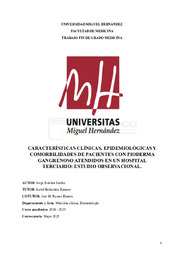Please use this identifier to cite or link to this item:
https://hdl.handle.net/11000/37688Características clínicas, epidemiológicas y comorbibilidades de pacientes con pioderma gangrenoso atendidos en un hospital terciario: estudio observacional.
| Title: Características clínicas, epidemiológicas y comorbibilidades de pacientes con pioderma gangrenoso atendidos en un hospital terciario: estudio observacional. |
| Authors: Esteban Jarabo, Jorge |
| Tutor: Belinchón Romero, Isabel Ramos Rincón, José Manuel |
| Editor: Universidad Miguel Hernández |
| Department: Departamentos de la UMH::Medicina Clínica |
| Issue Date: 2025-05-06 |
| URI: https://hdl.handle.net/11000/37688 |
| Abstract: Introducción y objetivos: El pioderma gangrenoso (PG) es una dermatosis inflamatoria crónica, rara y recidivante, caracterizada por lesiones ulcerativas cutáneas. Suele asociarse a enfermedades subyacentes como la enfermedad inflamatoria intestinal (EII), artritis reumatoide (AR) y neoplasias hematológicas. El objetivo de este estudio fue describir y analizar las características clínicoepidemiológicas de los pacientes con PG, evaluar las principales comorbilidades asociadas y los tratamientos utilizados, así como analizar las diferencias entre sexos. Métodos: Estudio retrospectivo basado en la revisión de historias clínicas de pacientes diagnosticados de PG atendidos en el Servicio de Dermatología del Hospital General Universitario Dr. Balmis de Alicante entre 2000 y 2024. Resultados: Se incluyeron 32 pacientes en el estudio. Las mujeres estuvieron significativamente más afectadas (75%, n=24) que los hombres (25%, n=8). Se observó una diferencia significativa en la edad al diagnóstico, siendo las mujeres notablemente más jóvenes (38 vs 61 años en hombres). También hubo diferencias significativas en la mortalidad, siendo menor en las mujeres (37,5% mortalidad en hombres vs 4,2% en mujeres). La variante ulcerativa fue la forma clínica más común (46,9%, n=15), seguida de las formas pustular (25%, n=8) y ampollosa (21,9%, n=7). Las lesiones se localizaron predominantemente en extremidades inferiores (86,4%, n=27), con una media de una lesión por paciente. La comorbilidad más frecuente fue la EII (21,9%, n=7), seguida por la AR (15,6%, n=5) y la artritis seronegativa (9,4%, n=3). El tratamiento más utilizado fue la combinación de corticoides sistémicos y ciclosporina, aunque los anti- TNF, especialmente Infliximab, mostraron la mejor respuesta, siendo reservados para casos graves o refractarios. Conclusiones: El PG predominó significativamente en mujeres jóvenes, asociándose con mayor frecuencia a EII y presentándose en su forma ulcerativa clásica en extremidades inferiores. Aunque la terapia combinada fue la más empleada, los biológicos demostraron mayor eficacia terapéutica. Background and objectives: Pyoderma gangrenosum (PG) is a chronic, rare and recurrent inflammatory dermatosis characterized by ulcerative lesions on the skin. This disease can often be associated with certain underlying diseases such as inflammatory bowel disease (IBD), rheumatoid arthritis (RA), and hematological malignancies. The aim of this study was to describe and analyze the clinical and epidemiological characteristics of patients with PG, evaluate the main comorbidities associated with PG and the treatment administered, as well as analyze the difference in these variables between sexes. Methods: We conducted a retrospective study using the clinical histories of 32 patients included in this investigation. These patients were attended by the Dermatology department from 2000 to 2024 in the Dr Balmis Alicante General Hospital. Results: Out of 32 patients, women were significantly more affected than men (75% and 25%, respectively). The median age at the time of diagnosis was notably lower in the female population at 31 years old, compared to 61 years old in the male population. Males took less time to achieve remission than females, but despite de shorter follow-up period, the deaths in this group were proportionally higher than in the women’s population. Almost 50% of patients presented ulcerative PG, followed by pustular and bullous variants. The most frequent location for the lesions was in the lower extremities followed by the trunk, with an average of 1 lesion per patient. The most common comorbidity in our cohort was IBD, followed by rheumatoid arthritis and seronegative arthritis. Overall, the treatment that achieved remission was the combination of systemic corticosteroids and cyclosporin. The best therapeutic response was to anti-TNF treatment, specifically infliximab, but such therapy was reserved for more severe, refractory cases of PG. Conclusions: PG predominated in the female population, presenting mainly as the classic ulcerative form in lower extremities, associated most frequently to IBD. The most used therapy was the combination of corticosteroids and cyclosporin, although the use of biological therapies showed the highest efficiency. |
| Keywords/Subjects: Pioderma gangrenoso Comorbilidades Sexo España Enfermedad inflamatoria intestinal Artritis reumatoide Artritis seronegativa Patergia |
| Knowledge area: CDU: Ciencias aplicadas: Medicina |
| Type of document: info:eu-repo/semantics/bachelorThesis |
| Access rights: info:eu-repo/semantics/openAccess Attribution-NonCommercial-NoDerivatives 4.0 Internacional |
| Appears in Collections: TFG- Medicina |
.png)

